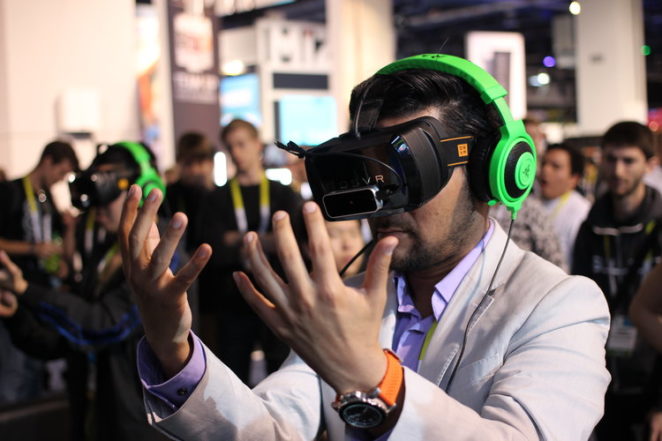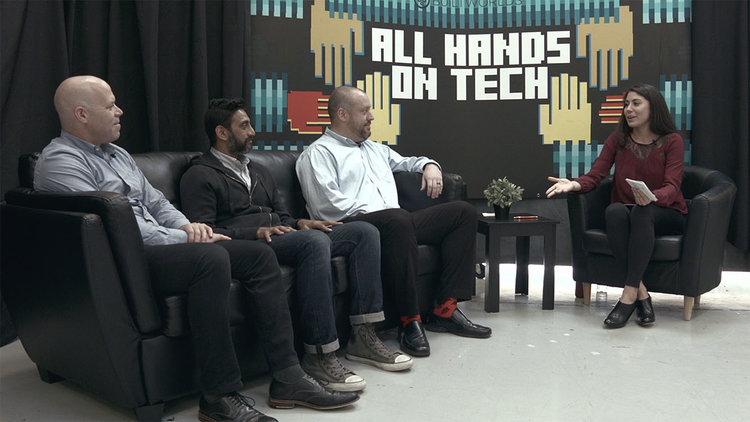Alexis Chastain speaks with (from left) Boaz Ashkenazy, Sanjay Mistry, and Lucas Richmond about the state of AR/VR in the construction and design fields for “All Hands on TGoogle
ech.”
Three-dimensional walking tours of structures that exist only as CAD or Revit files? Hands-on safety training without touching a single piece of equipment? Real-time design updates from the job site with the snap of a photo?
Augmented reality (AR) and virtual reality (VR) technologies could make such things possible, and like BIM software years ago, at least VR seems poised to take over and revolutionize development and construction processes and client engagement in the AEC market, according to Boaz Ashkenazy and Lucas Richmond, who participated in BuiltWorlds’ latest live-stream episode of “All Hands on Tech” along with Sanjay Mistry of VIMtrek.
“I think in two years you’re going to start to see clients push hard on being able to validate whatever they’re buying in VR,” says Ashkenazy, partner and CMO with Studio 216, a company that helps create virtual experiences of environments not yet built.
The VR sector as a whole is definitely experiencing rapid growth. According to Greenlight Insights, since 2010, the number of new VR companies appearing in the marketplace each year has risen from fewer than 40 to more than 160 in 2015, with funding for all VR companies jumping from $36 million to $281.5 million. And, Goldman Sachs Global Investment Research is predicting that the market for AR/VR head-mounted devices could reach $110 billion by 2020 as demand grows and sleeker, faster models replace current pricier products such as the Oculus Rift, the Samsung Gear VR, and the HTC Vive. Google’s recent cardboard device, which one can order online or build for free from a set of downloadable plans, is a good indicator of how cheap and readily available AR/VR technologies are likely to get.

The products are already seeing use by a number of architecture and construction firms. St. Louis-based McCarthy Building Companies, for example, walked doctors and nurses virtually through the plans for the Martin Luther King, Jr. Multi-Service Ambulatory Care Center in Los Angeles to understand where equipment needed to be placed and how spaces needed to be used before completing the facility. Additionally, the Gilbane Multimedia Studio and Richmond, its senior manager, are using VR to help architects and developers they’ve partnered with to visualize their projects and make tweaks before breaking ground.
As the technology becomes more widely available, high-paying clients are likely to want to use it, too. “For example, if someone’s going to buy a house for over $700,000, they’re going to want to experience it in VR first,” Ashkenazy says.
“I think in two years you’re going to start to see clients push hard on being able to validate whatever they’re buying in VR.”
And soon, money will become even less of a factor, and then the sky’s the limit. Richmond says his team is already working on a process for contractors and subcontractors to be able to take photo spheres (360-degree panoramas that also allow you to look up and down) from job sites and upload them for remote viewing in VR models, and he sees more in-house possibilities for the technology coming in the near future, including interactive safety training. “You always get the question, ‘Where’s this going to be in five years?’ ” he says. “You have no idea. I mean, you had no idea it was going to be here five years ago, so it’s just going to keep getting cheaper and faster, better-looking.”
Our “All Hands on Tech” live stream on AR/VR in the AEC market aired October 19. Look for an edited version on our site on November 1. In the meantime, check out other episodes of All Hands on Tech here.


Discussion
Be the first to leave a comment.
You must be a member of the BuiltWorlds community to join the discussion.